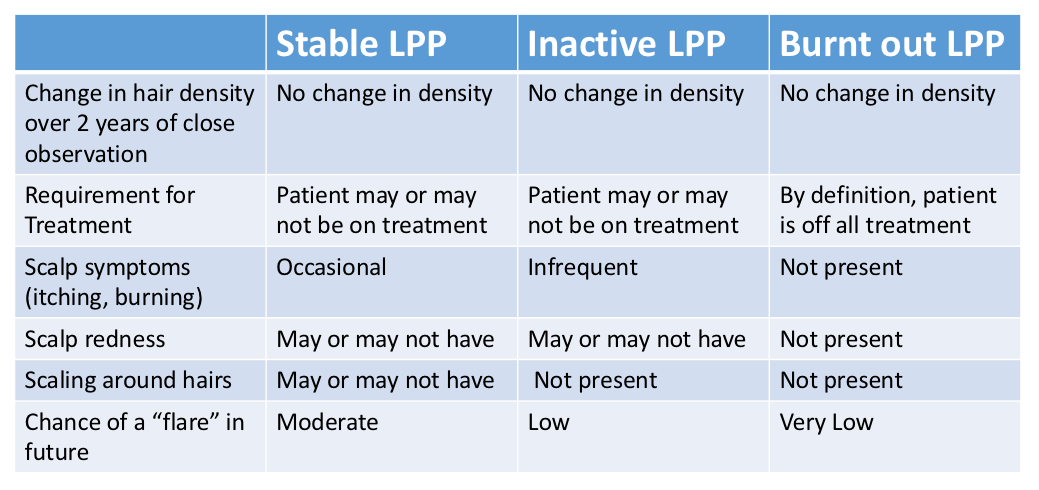Burnt out vs Stable/Inactive LPP: Not Quite the Same
What’s the difference between stable or inactive LPP and burnt out disease?
Lichen planopilaris is a type of scarring alopecia that is associated with redness, itching and burning in the scalp as well as ongoing hair loss. Treatments can help stop symptoms and signs of the disease and may help stop ongoing hair loss as well. Once the disease comes under control, physicians often use terms such as “inactive” and “burnt out.” Let’s take a closer look at these terms and what exactly they mean. They are often used incorrectly - so it’s important to get a good sense of what they really mean. The following table helps clarify some of these points.
What is inactive or stable LPP?
Inactive LPP and stable LPP refer to LPP that is not removing hair from the scalp. In my clinic, stable and inactive LPP are quite similar - although what constitutes inactive LPP is much stricter in definition than what constitutes stable LPP. As shown in the table, a patient with stable LPP or inactive LPP both have had no change in density over a fairly long period of observation. However, patients with stable LPP still may have a bit of redness or scaling in the scalp and may even have occassional symptoms. For patients with inactive LPP, redness and scaling and symptoms are uncommon.
Inactive LPP can potentially become active (although chances are low) and stable can potentially becomes unstable but for now they are not. LPP may be rendered inactive or stable from treatment or on it’s own. It is absolutely possible for inflammation to be present clinically and/or histologically and yet the patient’s density remain the same. Of course, that would not be the norm but it’s an important point that one would be making a mistake if they prescribe more and more drugs simply based on seeing inflammation on the scalp or under the microscope. The most important finding is whether hair density is changing and what sort of symptoms are remaining. There are occasional patients who maintain redness and even a bit of scale but yet do not have any significant loss of density over 5-10 years of follow up. Granted this is not the norm but it’s a good point to keep in mind that we really ought to be making decisions on LPP treatment based on changes in density first followed by clinical features second. They are both important but nothing more important than a photo.
What is burnt out LPP?
Now we come to the important point regarding what truly constitutes “burnt out” LPP. For this, we do need a much stricter definition. First and foremost, a patient with burnt out LPP is not on treatment. Absence of clinical features of inflammation must also be noted in order to say LPP is burnt out including absence of symptoms of itching and burning and absence of clinical signs of redness and scaling.
I think alot of patients and physicians go wrong with definitions of inactive vs burnt out. LPP can be stable or inactive with the patient having no change in hair density but not be burnt out. Burnt out means 1) no signs of inflammation and 2) no change in density a long period of follow up. LPP that is stable, even after 10 years of follow up, but not truly burnt out has a much much higher chance of flaring in the future. This is especially true when it comes to discussing issues such as hair transplant surgery. Inactive and stable LPP has a much higher likelihood of flaring and reactivating with hair transplant surgery compared to LPP that is truly burnt out.
This article was written by Dr. Jeff Donovan, a Canadian and US board certified dermatologist specializing exclusively in hair loss.

